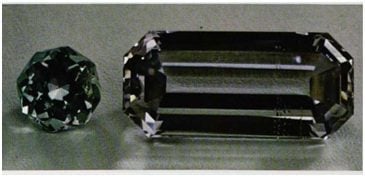Sillimanite Value, Price, and Jewelry Information
The fibrolite from Burma and Sri Lanka is well known to gem collectors, and highly prized because of its great scarcity. Blue and greenish gems are lovely, although very difficult to cut. Chatoyant material sometimes yields catseye fibrolites, which are also very rare. The material from Kenya is just as attractive as Burmese fibrolite but seems to be somewhat smaller in size.
The fibrolite from Burma and Sri Lanka is well known to gem collectors, and highly prized because of its great scarcity. Blue and greenish gems are lovely, although very difficult to cut. Chatoyant material sometimes yields catseye fibrolites, which are also very rare. The material from Kenya is just as attractive as Burmese fibrolite but seems to be somewhat smaller in size.
Start an IGS Membership today
for full access to our price guide (updated monthly).Sillimanite Value
SILLIMANITE (=FIBROLITE) Trimorphous with Kyanite, Andalusite.
Optics: a =1.654-1.661 β= 1.658-1.662; γ= 1.673-1.683.
Biaxial (+), 2V: 21—30°.
Occurrence: A mineral of metamorphic rocks, such as schists and gneiss; also granites.
Idaho; South Dakota; Oklahoma; Pennsylvania; New York; Connecticut; Delaware; North Carolina; South Carolina.
Canada; Ireland; Scotland; France: Germany; Czech Republic; Slovakia; Brazil; India; Madagascar; North Korea; South Africa; Tanzania.
Sri Lanka and Burma: green, blue. violet—blue facetable material; also from Sri Lanka, grayish green, chatoyant fibrolite.
Kenya: facetable crystals, pale bluish color to colorless, S.G. 3.27.
Comments: The fibrolite from Burma and Sri Lanka is well known to gem collectors, and highly prized because of its great scarcity. Blue and greenish gems are lovely, although very difficult to cut. Chatoyant material sometimes yields catseye fibrolites, which are also very rare. The material from Kenya is just as attractive as Burmese fibrolite but seems to be somewhat smaller in size.
Name: After Benjamin Silliman, mineralogist, of Yale University. Fibrolite is in allusion to the fibrous nature of this variety.
Joel E. Arem, Ph.D., FGA
Dr. Joel E. Arem has more than 60 years of experience in the world of gems and minerals. After obtaining his Ph.D. in Mineralogy from Harvard University, he has published numerous books that are still among the most widely used references and guidebooks on crystals, gems and minerals in the world.
Co-founder and President of numerous organizations, Dr. Arem has enjoyed a lifelong career in mineralogy and gemology. He has been a Smithsonian scientist and Curator, a consultant to many well-known companies and institutions, and a prolific author and speaker. Although his main activities have been as a gem cutter and dealer, his focus has always been education. joelarem.com
Related Articles
Black Diamond Value, Price, and Jewelry Information
Chameleon Diamond Value, Price, and Jewelry Information
Gray Diamond Value, Price, and Jewelry Information
Green Diamond Value, Price, and Jewelry Information
Latest Articles
Rhodochrosite Value, Price, and Jewelry Information
Ruby and Sapphire Survey: Where Do You Draw the Line?
Quartz Toxicity: Understanding the Risks for Jewelers and Wearers
Synthetic Amethyst: What is it and How is it Made?
Never Stop Learning
When you join the IGS community, you get trusted diamond & gemstone information when you need it.
Get Gemology Insights
Get started with the International Gem Society’s free guide to gemstone identification. Join our weekly newsletter & get a free copy of the Gem ID Checklist!
